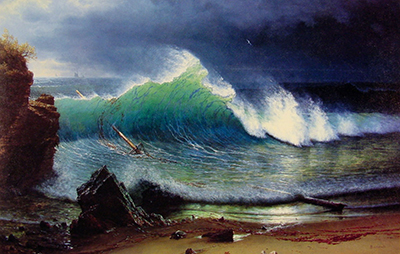The Shore of the Turquoise Sea by Albert Bierstadt, an oil on canvas work of 1878, is not typical of this artist's output. He was more often concerned with conventional landscapes that glorified nature, but this restless seascape is thought to suggest an allegory.
At the time, Albert Bierstadt was a resident of Nassau in the Bahamas, so it's not impossible that it is simply a rendition of one of the many beaches that he must have visited. However, Bierstadt's wife was suffering from TB, so it is generally thought that The Shore of the Turquoise Sea could be a metaphor on this situation in both his life, and theirs. Instead of portraying an idyllic scene on one of the beautiful beaches around him, Bierstadt has concentrated here on a massive wave breaking on a rock, with the remains of a wrecked ship in the foreground. In The Shore of the Turquoise Sea, the artist was moved to portray the destructive forces that the sea can unleash. Just as with illness, people can be helpless against nature, which was especially true of disease at that time, and is still the case with the oceans today.
Predominantly worked in blue and turquoise, the high waves and floating mast suggest that a ship has met a violent end in the storm. A shipwreck suggests the likelihood of deaths, making a further link with the failing health of Bierstadt's wife. Dark clouds reinforce feelings of foreboding and hopelessness. Albert Bierstadt's more usual landscapes romanticised the wild scenery of the United States and elsewhere. The Shore of the Turquoise Sea is also romantic in a way, with its dramatic subject matter. Born in Germany in 1830, but living his childhood in the United States, he had to return to the country of his birth to find mentors who were, ironically, Americans - Emanuel Leutze and Worthington Whittredge - and who influenced the direction of his future art.
Bierstadt applied opaque paint with the minimum of brush strokes that emphasised fluidity. Although his paintings were much sought-after by art lovers at the time, the critics didn't share their enthusiasm. This, and changing tastes, meant that by the time he died in 1902, he was not well known. Today, his pictures represent an idealised version of the American West, which influenced later American painters. Although Albert Bierstadt's The Shore of the Turquoise Sea isn't one of these inland scenes, it carries the same force, while its metaphorical aspects give it an extra dimension. Fittingly, it is held in the Manoogian Collection, along with other American paintings, at the Detroit Institute of Arts.




